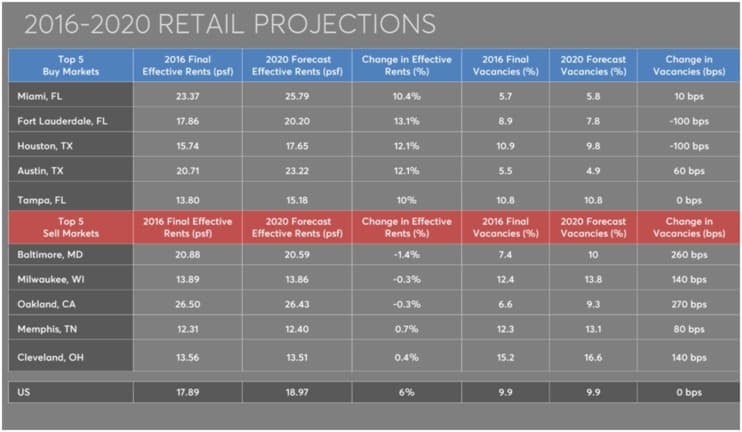Ten-X Research identifies Miami, Fort Lauderdale, Houston, Austin and Tampa as top ‘Buy’ markets for retail investors
Ten-X, the nation’s leading online real estate marketplace, today released its latest U.S. Retail Market Outlook, including the top five ‘Buy’ and ‘Sell’ markets for retail real estate assets. The long-term forecast depictsa retail sectorthat continues to stagnate, duein large part to secular trends in technology and consumer behavior that stand in the way of significant growth.
The long-term forecast reveals Miami, Fort Lauderdale, Houston, Austin and Tampa as markets in which investors should consider buying retail assets. These markets, concentrated in Florida and Texas, have been able to defy national trends, primarily thanks to robust local economies fueled by consistent job and population growth.
Baltimore, Milwaukee, Oakland, Memphis and Cleveland are the top markets in which Ten-X Research suggests that market conditions might cause investors to consider selling retail properties. These cities serve as a testament to weak economic and demographic indicators that exist in much of the Midwest and Northeast, where shrinking or stagnating populations and weak demand continue to create a difficult climate for retail properties.
The Ten-X Research report notes that e-commerce – the single largest secular threat to traditional retail – now comprises more than 13 percent of the industry’s sales, resulting in “agonizingly slow” growth in retail fundamentals.That share has been rising for years and shows little signs of slowing, leading big-box retailers to either close or downsize many of their stores.Hedge fundshave increasingly been shorting real estate investment trusts and bonds tied to shopping malls, adding even more fuel to the already powerful headwinds facing the sector.
“Consumers have been turning away from traditional retail for years, which is creating a more challenged and fraught landscape for investors.While healthy economic conditions and strong housing markets are fuelingthe sector in some areas of the Southeast and West, even those regions would bear the brunt of weakening absorption and falling rents that could push vacancies to recession-era levels in the event of any cyclical economic headwinds,” said Ten-X Chief Economist Peter Muoio.“The problems inhibiting retail’s growth are anything but a passing phase, and the mounting shift toward online shopping ensures the sector will continue to face a steep climb on its road to recovery.”
Duringthe quarter, effective rents measured at 1.9 percent above year-ago figures to surpass their pre-recession peak, while vacancies ticked down by 10 bps to 9.9 percent. Overall deal volume in the sector was $18.6 billion - a 22.4 percent decline from the same period in 2015.

The Retail Sector’s Top Five ‘Buy’ Markets:
Miami
Miami’s economic fortunes have begun to stabilize, making it an ideal spot for retail investment. Local employment is at an all-time peak after increasing 2 percent over the last year, fueled by healthy gains in the city’s leisure/hospitality sector. The positive signs have translated into stellar rent growth for retail properties, with rents now at an all-time high and poised to increase more than 3 percent in 2018, according to Ten-X Research. Vacancies have dropped significantly to a cycle-low 5.7 percent, and should continue to drop as new supply remains sparse. Property owners can expect NOIs to grow by roughly 10 percent during 2017, before gains slow to a still-healthy 4.3 percent the following year.
Fort Lauderdale
Retail conditions are also inviting for investors in another South Florida city, Fort Lauderdale. Despite a spike in retail completions during 2016, vacancies declined to 8.9 percent in the area, while effective rents grew 2.8 percent. Rents should continue to accelerate in the years to come, while occupancy rates will remain healthy, leading to NOI growth of more than 4 percent through 2018. The area’s prosperity is bolstered by a robust economy, including an unemployment rate below the national average, and total employment figures which reached an all-time high in 2016.
Houston
Though the prolonged slump in oil prices continues to be a drag on Houston’s economy, its retail market remains a bright spot. Fueled by booming population growth that more than tripled the U.S. rate, the metro’s retail jobs jumped 5.1 percent over the last year – the healthiest growth of the current cycle. Demand in the market has been enough to withstand more than 1.7 million square feet of new supply in 2016, as vacancies remained unchanged over the course of the year and should descend in the years to come. Rents are at an all-time high after rising 3 percent over 2015 figures; Ten-X Research expects that investors will reap healthy annual returns of 3.8 percent through 2018, and roughly 2.6 percent over the two years to follow.
Austin
Austin’s exploding population has been good news for its economy, as the metro now claims more than one million jobs. Retail jobssaw particularly strong growth, climbing 2.8 percent during 2016. The city’s vacancy rate has descended more than 400 bps from its peak to a healthy 5.5 percent, even as new supply has been delivered in each of the last seven quarters. That pipeline is expected to thin through 2018, inflating rents even higher than their current all-time peak. While rent growth is expected to cool during a modeled downturn in 2019-2020, consistently low vacancy rates should continue to spell significant returns for investors.
Tampa
A wave of new completions in 2016 bumped Tampa’s retail vacancy rate up slightly to 10.8 percent, but the city’s low unemployment and strong job growth continue to make it a solid bet for investors. Tampa’s population grew by 2 percent in 2015 – the city’s highest rate in a decade – while retail jobs expanded by 2.9 percent last year. Retail rents enjoyed their best growth of the cycle in 2016, jumping 4.2 percent. Ten-X Research projects rising rents will continue as demand overtakes a modest supply pipeline, generating annual NOI growth of 4.5 percent through 2018.
The RetailSector’s Top Five ‘Sell’ Markets:
Baltimore
Charm City continues to add jobs, posting annual employment growth of 1.7 percent in 2016. Demographics remain a challenge for the area, however, as population growth has now cooled for four straight years, and has lagged behind the national average for decades. Retail deliveries hit a 15-year high last year, driving vacancies up to 7.4 percent. The modeled downturn scenario in 2019 and 2020 is casting a pall over the city’s retail outlook, as rent growth is expected to sour and vacancies are projected to exceed 10 percent. Those weak fundamentals make Baltimore among the least appealing markets for investors, as Ten-X Research projects that annual returns willaverage less than 2 percent through 2018.
Milwaukee
Milwaukeesaw a dramatic 6.1 percent increase in retail jobs during 2016, but the city’s potential remains very limited due to its stagnant population growth. The city posted its weakest population increase in a decade during 2015, and experienced contracting employment figures last year. Those dynamics have kept retail vacancies elevated at 12.4 percent, just 100 bps below their peak, according to Reis data. Demand will continue to lag supply in the years to come, driving vacancies to an unprecedented 13.8 percent by 2020, while annual rent growth remains sluggish, at roughly 0.8 percent. NOIs are projected to rise slightly through 2018 before falling off sharply due to an economic downturn.
Oakland
While Oakland boasts strong economic fundamentals, including a low unemployment rate and solid population growth, its retail market continues to underperform. While overall job growth outpaced the national rate in 2016, retail jobs gained a meager 0.1 percent and contracted in four of the last five months to close the year.Retail vacancies have hovered in the mid-6 percent range, as a modest new supply pipeline has coincided with very weak absorption. These dynamics should drive vacancies above 9 percent by 2020, as more deliveries arrive in the coming years. Rents should continue to rise annually by nearly 2 percent through 2018, allowing for modest NOI growth before a sharp contraction beginning in 2019.
Memphis
A combination of modest rent growth and weak demand continues to limit returns for retail investors in Memphis. The city has been unable to capitalize on a very sparse supply pipeline, as vacancies sit at 12.4 percent — just 100 bps lower than their peak. Effective rents are at peak levels, but they increased by just 0.6 percent during 2016, and are not expected to exceed 1 percent annual growth through 2018. Unemployment has fallen 80 bps over the last year to 5.3 percent, though uneven monthly job gains have kept the metro’s rate above the national average. Weak demographic growth poses an additional barrier to economic expansion, as Memphis’ population has increasedby 0.1 percent or lessannually in each year since 2013. Ten-X Research projects NOI growth to be modest through 2018 before contracting in the years to follow.
Cleveland
Total employment in Cleveland grew 1.1 percent over the last year, but its economy still faces long-term challenges that harm prospects for retail investors. The city’s once-mighty manufacturing sector continues its lengthy structural decline, while the market continues to struggle with a shrinking population and rising unemployment. At 15.2 percent, Cleveland’s retail vacancy rate is nearly double its pre-recession level, thanks to negative demand in seven of the last 10 years. Ten-X Research notes that the resulting high availability will continue to depress rent growth, with rents expected to rise about 1.7 percent annually before flattening altogether in 2019 and 2020. Given its weak fundamentals, Cleveland’s retail investors can expect annual NOI growth of less than 1 percent over the next four years.
About Ten-X
Ten-X is the nation’s leading online real estate transaction marketplace and the parent to Ten-X Homes, Ten-X Commercial and Auction.com. To date, the company has sold 275,000+ residential and commercial properties totaling nearly $46 billion. Leveraging desktop and mobile technology, Ten-X allows people to safely and easily complete real estate transactions online.Ten-X is headquartered in Irvine and Silicon Valley, Calif., and has offices in key markets nationwide. Investors in the company include CapitalG (formerly Google Capital) and Stone Point Capital.For more information, visit Ten-X.com.






